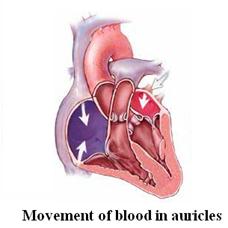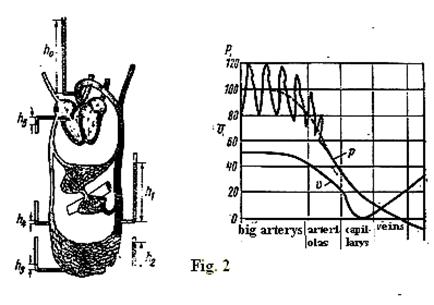 |
АвтоАвтоматизацияАрхитектураАстрономияАудитБиологияБухгалтерияВоенное делоГенетикаГеографияГеологияГосударствоДомДругоеЖурналистика и СМИИзобретательствоИностранные языкиИнформатикаИскусствоИсторияКомпьютерыКулинарияКультураЛексикологияЛитератураЛогикаМаркетингМатематикаМашиностроениеМедицинаМенеджментМеталлы и СваркаМеханикаМузыкаНаселениеОбразованиеОхрана безопасности жизниОхрана ТрудаПедагогикаПолитикаПравоПриборостроениеПрограммированиеПроизводствоПромышленностьПсихологияРадиоРегилияСвязьСоциологияСпортСтандартизацияСтроительствоТехнологииТорговляТуризмФизикаФизиологияФилософияФинансыХимияХозяйствоЦеннообразованиеЧерчениеЭкологияЭконометрикаЭкономикаЭлектроникаЮриспунденкция
Laws of movement of blood in an arterial and venous channel
|
Читайте также: |
Hemodynamics is one of sections of the biomechanics, studying laws of movement of blood on blood vessels. The problem of hemodynamics is to establish interrelation between the cores hemodynamic parameters, and their dependence on physical parameters of blood and blood vessels. Pressure and speed of a blood-groove concern to the basic hemodynamic parameters. Pressure is the force operating from blood on unit of the area of a blood vessel. Speed of a blood-groove is divided on volumetric and linear speed. The value numerically equal to volume of a liquid, proceeding in unit of time through the given section of a pipe is called volumetric speed of blood-grooveQ: Q=V/t. Linear speed is a way which is passed by particles of blood in unit of time: v=l/t. Speed of blood in different vessels different, therefore we speak about average speed. Linear and volumetric speeds are connected by simple parity Q=vS, where S is the area of cross-section of a liquid stream. The condition of indissolubility of a jet for continuous current of an incompressible liquid is carried out: through any section of a jet identical volumes of a liquid in unit of time proceed: Q=vS=const. For hemodynamic it is possible to formulate this law so: in any section of cardiovascular system volumetric speed of a blood-groove is identical.
Physical model of vascular system. Work of heart.
The physical model of cardiovascular system can be presented in the form of closed (not having the message with an atmosphere), repeatedly branched out and filled liquid of system of pipes with elastic walls. Movement of a liquid in this system occurs under action working, delivery pump (on fig.1 in the form of a rubber pear). At compression of the pear, a volume of a liquid, which there is in the pear, is pushing through valve K1 in system of pipes from side A, causing in them movement of liquid to side B, then valve K1 is locked, the pear extends and corresponding volume of a liquid goes in it through valve K2 from side B.
Feature of the given system is, first of all, the gradual and plural branching of pipes. The average part consists of rather big number of short parallel pipes of small section which general gleam has so big section, that speed of a liquid here decreases almost to zero.



Internal friction in layers which are about walls of these pipes so is great, to what exactly this average part of system represents the greatest resistance to current of a liquid and causes the maximal pressure drop.
Other feature of system is elasticity of walls of pipes. The current of a liquid in system accepts uniform character at work of the pump. We shall admit, that a quantity of a liquid is poured in a pipe A at compression of the pear, already filled by a liquid under some pressure. Pressure in a pipe A raises, its elastic walls are stretched and contain surplus of liquid. Then walls of a pipe A are gradually reduced and push out surplus of a liquid in a following site of system. Walls of a following site also all over again are stretched, then reduced and thus push a liquid in the subsequent sites system of pipes. As a result current of a liquid gradually accepts uniform character.
We pass to vascular system. The initial pressure necessary for promotion of blood on all vascular system is created by work of heart. Let's consider schematically the phenomena occurring in the big circle of blood circulation. Some volume of blood is pushed out at each reduction left ventricle of heart in an aorta, already filled by blood under corresponding pressure. This volume refers to shock volume of blood, on the average equal to 65-70 ml. Then valves of an aorta are closed.
The additional volume of the blood which has acted in an aorta raises pressure in it and accordingly stretches its walls. The wave of the raised pressure which is called systolic pressure causes fluctuations of vascular walls. These fluctuations extend lengthways larger arteries in the form of an elastic wave. This wave of pressure is called a pulse wave; speed of its distribution depends upon elasticity of vascular walls and is approximately equal 6-8 m/s.
Then walls of an aorta are gradually reduced up to a starting position and push the acted volume of blood in adjoining large arteries. It is the period of a relaxation of a cardiac muscle – diastole ( pressure of blood during this moment is called diastolic pressure). Walls of following vessels are stretched and then, being reduced, push blood in the subsequent parts of vascular system. As a result the current of blood accepts continuous character with a speed in large vessels 0,3-0,5 km/s.
 Only the part of the energy developed by a cardiac muscle at reduction is transferred weight of blood in an aorta and passes in its kinetic energy. Other part of energy passes in potential energy of deformation of a stretching of elastic walls of large vessels (basically aortas). Then this part of energy is transferred weight of blood during a relaxation of a cardiac muscle.
Only the part of the energy developed by a cardiac muscle at reduction is transferred weight of blood in an aorta and passes in its kinetic energy. Other part of energy passes in potential energy of deformation of a stretching of elastic walls of large vessels (basically aortas). Then this part of energy is transferred weight of blood during a relaxation of a cardiac muscle.
Quantity Q of blood proceeding through cross-section of the part of vascular system in unit of time is called volumetric speed of a blood-groove. Volumetric speed of a blood-groove depends upon a difference of pressure in the beginning and the end of a site and its resistance to a current of blood.
Volumetric speed on separate sites of vascular system is calculated under formula Gagen-Puazal, but resistance to a current of blood in vascular system above, because there are losses of energy at its deformation elastic walls, and also inevitable turbulences in places of a branching.
Resistance to a current of blood and consequently, and pressure drop on various sites of vascular system are rather various. It depends on the general gleam and number of vessels in a branching. The greatest pressure drop of blood - not less than 50 % from initial pressure - occurs in arterioles. Quantity of arterioles in hundreds times more numbers of large arteries at rather small increase in the general gleam of vessels. Therefore losses of pressure from friction in them are rather great. The general number of capillaries even more, however, it is long them it is so small, that pressure drop of blood in them is less, than in arterioles.
Speed of current of blood is low in a network of venous vessels which area of section twice is more the than area of section of corresponding arteries, and pressure drop are insignificant. In large veins about heart pressure becomes on some millimeters of a mercury column below atmospheric. In these conditions blood moves under influence of soaking up action of a thorax a t a breath.
On fig. 2 distribution of pressure of blood in separate parts of system of vessels of the big circle of blood circulation is schematically shown. On fig. 2 schedules of change of pressure and speed of movement of blood in the basic parts of vascular system are resulted. Movement of blood on vessels, especially its distribution between different parts of vascular system, depends not only on work of heart, but also from the general gleam of vessels caused by a tone of vascular walls. Smooth muscular fibers are in elastic walls of a vessel, the gleam of a vessel depends on a degree of their reduction. It is important also total circulating of blood and its viscosity. All these factors are under adjusting influence of the central nervous system. Thus, physiological factors control blood circulation in various parts of an organism.
The vascular system is closed and has no message with an atmosphere in norm. Vessels settle down in various directions, and arterial and venous vessels on which blood moves in opposite directions, are parallel. These vessels are informed among themselves through capillaries, therefore it is possible to consider, that hydrostatic pressure of blood in them as in informed vessels, and it is mutually counterbalanced, and as models it is possible to consider system of horizontal pipes.
In case of damage of a vascular wall the message of a vessel with an atmosphere and then action hydrostatic pressure of blood is shown can be formed. For example, for reduction of a bleeding from the wounded vessel of finiteness, it should give the raised position.
Current of blood in vascular system in normal conditions has laminar character. It can pass in turbulent at infringement of these conditions, for example at sharp narrowing a gleam of a vessel. The similar phenomena can take place at incomplete opening or, on the contrary, at incomplete closing of valves of an aorta. Thus there are the sounds, which are called cardiac noise. They are characteristic attributes of this phenomenon.
The work of heart, basically develops of work at reduction ventricle, mainly left (work of right ventricle is accepted equal 0,2-0,15 from work left.) Work of a cardiac muscle at each reduction left ventricle is spent for the message to volume of pushed out blood of the energy necessary for its promotion on all circle of blood circulation. This energy consists of potential energy of pressure which must to be created in the beginning for overcoming resistance to movement of blood on its all way, and kinetic energy for the message to weight of blood of necessary speed of movement. On the basis of data this energy can be presented by the formula

Where р - average pressure under which blood is thrown out in an aorta, р =1,3·104 Pa; ρ = 1,05 103 kg/m3 - density of blood; υa ≈ 0.5 м/с speed of blood in an aorta, in a condition of rest Vs = 70 cm3 = 7∙10-5 m3 shock volume of blood in rest on the average

Considering work right ventricle, for heart as a whole we shall find

Time of reduction ventricles tv =0.3 sec. Then the power capacity developed by heart at reduction, will be

Including on the average 60 reductions of heart 1 minute, we shall receive, that for 1 minute it makes work Amin≈ 68 J and in 1 day A=98000 J
At calculation of work of heart it is possible to consider minute volume of blood Vмин, equal to product of shock volume on number of reductions of heart N in 1 minute: V min =NVs
In ours example Vmin = 60 Vs= 4200 mllitre/minute, or 4,2 litre/minute.
At muscular work of average intensity the minute volume of blood increases approximately five times, V=20 litre/minute. Thus speed of current of blood in aorta υa=5∙0.5=2.5 m/sec accordingly increases. Then the work made by heart in 1 minute, will be
Ah ≈ 360 J
Поиск по сайту: